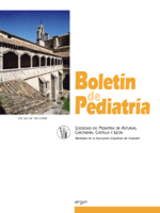Niveles normales de interleucinas 6 y 8 en suero y orina de niños sanos asintomáticos
J.M. Marugán Miguelsanz , M.A. Suárez Rodríguez , L.M. Rodríguez Fernández , J.M. García Ruiz de Morales
Bol. Pediatr. 2005; 45 (193): 177 - 184
Introducción: La infección urinaria es una patología muy frecuente en niños, y su diagnóstico y tratamiento precoces dependen de la sospecha clínica y la aplicación de parámetros analíticos. Objetivo: Conocer los niveles de las interleucinas (IL) 6 y 8 en sangre y orina en niños sanos, y establecer el rango de normalidad de nuestro laboratorio. Material y métodos: Estudio en niños sanos sin infección urinaria. Se analizan las variables sexo, edad, niño mayor o menor de 1 año, y nivel de IL 6 y 8 en sangre y orina (mediante ELISA). Se calcula la estadística básica de las variables cuantitativas. La comparación entre muestras independientes se llevó a cabo con el test U de Mann-Whitney, y la correlación entre las mismas con el test de Pearson. Resultados: Estudiamos 52 niños (40 varones, 76,92%) con una edad media de 51,31 + 47,98 meses (1-149 meses), sin diferencias en su distribución por sexo y grupos de edadinferior o superior a un año. Los niveles medios de IL (e intervalo de confianza IC: 95%), y el límite superior de la normalidad, fueron respectivamente, para IL-6 suero: 0,49 (IC: 0-1,05), y 3,95 pg/mL; IL-6 orina: 0,17 (IC: 0-0,51), 1,83 pg/mL; IL-8 suero: 136,66 (IC: 0,74-272,58), 974,58 pg/mL; IL-8 orina: 47,23 (14,71-79,75), 242,39 pg/mL. No hubo diferencias entre ambos sexos ni grupos de edad, salvo niveles medios de IL-8 urinaria más elevados en menores de 1 año, con una correlación negativa entre dicha variable y edad (p<0,05). Asimismo, existe una correlación positiva y muy significativa de IL-6 y 8 en orina (p<0,001) y de IL-8 entre suero y orina (p<0,01). Conclusiones: En niños sanos, no se observaron diferencias según sexos en los niveles de IL-6 y 8, pero la producción de IL-8 en orina es mayor en niños más pequeños. A diferencia de la IL-6, se detectan niveles significativos de IL-8 en suero y orina de niños sanos, cuestionando su validez en el diagnóstico de infección. Finalmente, existe encondiciones normales una excelente correlación entre IL-6 y 8 en orina. Abstract Objective: To determine the interleukins (IL) 6 and 8 levels in serum and urine in the healthy pediatric population, and to establish our laboratory reference values. Material and methods: Study, in healthy children without urinary tract infection. We analyse the following variables: sex, age, to be oldest or youngest than 1 year, and IL-6 and IL-8 levels in serum and urine (ELISA). We evaluate the basic statistics for quantitative variables. It compare the independent samples by means of Mann-Whitney U test, and its correlation with the Pearson test. Results:We have studied 52 children (40 males, 76.92%). The mean of age was 51.31 + 47.98 months (1-149 months), and it didn?t have differences according to sex, or to be oldest and youngest than 1 year of age. The mean values of IL (and confidence interval IC: 95%), and the upper limit of normality, respectively were for serum IL-6: 0.49 (IC: 0-1,05), and 3.95 pg/mL; urine IL-6: 0,17 (IC: 0-0,51), 1,83 pg/mL; serum IL-8: 136,66 (IC: 0,74-272,58), 974,58 pg/mL; and urine IL-8: 47,23 (14,71-79,75), 242,39 pg/mL. It didn?t have differences neither between both sex nor age groups, except urine IL-8 mean levels greater in youngest of 1 year of age, with a negative correlation between this variable and age (p<0,05). Moreover, it exist a positive and very significant correlation of urine IL-6 and 8 (p<0,001), and serum and urine IL-8 (p<0,01). Conclusions: In healthy pediatric population, it didn?t observe differences according to sex in IL-6 and IL-8 levels, but the urine IL-8 production is greater in more little children. It observe significant serum and urine IL-8 levels in healthy children, making questionable its validity in urinary tract infection diagnosis. Finally, it exist an excellent correlation between urinary IL-6 and IL-8 in normal conditions.
\N
\N
Artículo completo (PDF) (90 kb.)
- Inmunoalergia
Buscar en el boletín
Año 2005, Volumen 45, Número 193

Boletín completo en PDF (497 kb.)